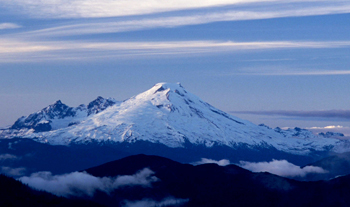Mt. Baker History
 Mt. Baker has had many names over the centuries. Before the arrival of Europeans it was known as Koma Kulshan, meaning "Great White Watcher." The first European name for the volcano comes from the maps of Spanish mariner Gonzalo Lopez de Haro who labeled the mountain "La Gran Montana del Carmelo" in 1790.
Mt. Baker has had many names over the centuries. Before the arrival of Europeans it was known as Koma Kulshan, meaning "Great White Watcher." The first European name for the volcano comes from the maps of Spanish mariner Gonzalo Lopez de Haro who labeled the mountain "La Gran Montana del Carmelo" in 1790.
The modern nomenclature, however, did not come until 1792, when Joseph Baker, third-lieutenant to English Captain George Vancouver on the British ship Discovery, spied the mountain while in the Strait of Juan de Fuca. It was not until nearly three-quarters of a century later that anyone took any interest in climbing the glacier-clad peak.
Edmund Thomas Coleman, an Englishman residing in nearby Victoria, Canada, and veteran of the Alps, made the first attempt to ascend the mountain in 1866, choosing a route via the Skagit River, but was forced to turn back when Native Americans refused him passage.
For his second attempt later that year Coleman recruited Edward Eldridge, John Bennett and John Tennant. After approaching from the North Fork of the Nooksack River, the party navigated what is now known as Coleman Glacier and ascended to within several hundred feet of the summit before turning back in the face of an "overhanging cornice of ice" and threatening weather conditions.
Undaunted by failure, Coleman returned two years later in 1868 and proved that the third time is indeed a charm. At 4 p.m. on the 17th of August, Coleman, Eldridge, Tennant and two new companions named David Ogilvy and Thomas Stratton gained the summit.
Since that August afternoon 130 some years ago, Mt. Baker has grown to be one of the most popular climbing destinations in the Cascades. Each year scores of climbers flock to its slopes and try to tame the "Great White One."
Alerts & Warnings
- Mallardy Ridge Trailhead and FSR 4030 and 4032 Closure
- Harris Lake Trailhead and FSR 5510 Closed
- Middle Fork Camping Closure
- Delays possible on PCT at the Summit at Snoqualmie Ski Area
- FSR 4110 Road Closure
- Camping Restrictions
- Fireworks and Explosive Targets Prohibition
- Read this Before Climbing or Backpacking on Mt. Baker
- Hwy 542 Closed to Artist Point
- New food storage rules for Mt. Baker-Snoqualmie NF
- Alcohol Prohibitions

